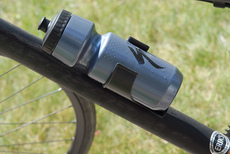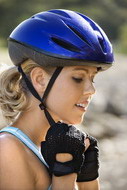Day touring and longer trips
If you are planning to go on day trips or do longer rides, such as multi-day events, it’s worth ensuring you have the skills to do basic bike maintenance and repairs. These skills should include fixing a puncture, tightening nuts and bolts, adjusting brakes and basic wheel changing.
Food and water
 You should carry at least one plastic water bottle and for hotter trips two water bottles are ideal.
You should carry at least one plastic water bottle and for hotter trips two water bottles are ideal.- Cyclists find that dehydration is a common cause of fatigue, fade out and headaches. It can lead to more serious conditions such as heat stroke. It is easy to prevent dehydration if a few precautions are followed.
- Before you start riding, drink a glass or more of water.
- Sports drinks are designed to replace lost fluids and salts in the body. They can make you feel thirstier. We suggest you carry one sports mix and one fresh water bottle for long rides.
- As you cycle, on warm days drink regularly every 10-15 minutes, or more frequently if very hot. Don’t wait until you feel thirsty as it will be too late and refill your bottles at every opportunity.
- Cycling is energy-consuming work, so don’t skip a hearty breakfast. On the trip bananas, apples, bread with various fillings, fruitcake and ‘health’ bars are a few suggestions to carry with you.
- Practice eating when you are out riding and avoid over-eating as it can cause discomfort.
Gear and clothing checklist
- Helmets are compulsory for all cyclists and to be effective they must fit properly and be worn secured in the correct manner.
- Shoes with stiff rubber soles or runners are sufficient. Special touring and cycling shoes can help to make the energy transfer through the pedals more efficiently.
- Proper cycling shorts with a padded crotch help absorb some of the road shock and prevents chaffing. They are worn without underpants for increased comfort, but do need to be washed regularly.
- Cycling gloves with padding in the palms provide more comfort, safety and give a better grip on the handle grips. They also protect your hands in the event of an accidental spill.
- Bright highly visible wet weather gear so you can be seen. It should be carried at all times – just in case the weather turns, but look for gear which breathes and is easy to fold away.
- Sunburn and windburn are big risks for cyclists, so wear shirts with collars and long sleeves (loose shirts can be worn over T-shirts), lightweight scarves to protect the back of your neck and flap hats that can be worn under your helmet.
- Use a 30+ sunscreen to cover all exposed areas of skin including your knees and shins and don’t forget the back of your hands. Avoid putting sunscreen on your forehead as once you start to sweat it will run into your eyes and burn!
- Good riding glasses will provide shade during the daytime and prevent flying debris from getting in your eyes.

News & Info Sections
-
News
(38 items)
-
Information
(30 items)
-
Tips
(18 items)
-
Offers
(2 items)
-
Ideas and suggestions
(13 items)
-
Headlines
(25 items)
-
Ride to work
(20 items)




